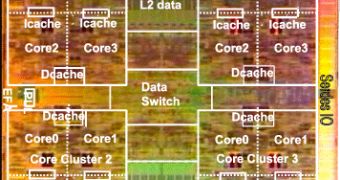The ongoing International Solid State Circuits Conference unveiled some extremely juicy details about Intel's products and roadmap, and I'm sure that the party is far from being over. However, Intel may be an important guest, but let's not underestimate the other participants. Sun, for example is less acclaimed than Intel, yet its new SPARC processor is as heavy and as powerful as the Itanium-based behemoth I have told you about yesterday.
It's true, the main difference between Intel's Tuckwila and the Rock is some million of transistors. The SPARC sports 16 cores (32 threads) and runs a 2.3GHz, but has a huge thermal envelope of 240 Watts, that is guaranteed to scorch everything around it. Sun had to perform multiple architecture stunts in order to give birth to this behemoth in both functionality and in chip-level design, but these features make it special on the high-end server market.
The first odd feature of the Rock is its out-of-order retirement processing. While "normal" CPUs would reorder the instruction stream, execute it, and then put it back in program order before retirement, Sun's processor retires some of the instructions out of program order. The reason behind this strange arrangement is found in the amount of logic required to track and retire instructions. This way, the allocated memory would increase considerably, and so will its latencies. The CPU merely forks the instruction stream and executes it two times.
The chip's layout is also impressive: it contains 16 cores that are grouped in four clusters of four cores each. The clusters are interconnected through a central crossbar switch. The processor is built on the older 65-nanometer production node (that explains its huge thermal envelope) and has a die size of 396 square-millimeters. Each core is 14 square-millimeter large and dissipates 10W.
The processor does not come with amazing core speeds, as it would have been expected for such a monolith, but it is one of the most interesting and efficient layouts in the processor industry. Sun's Rock will be unveiled later this year, but it will become commercially available in early 2009.

 14 DAY TRIAL //
14 DAY TRIAL //